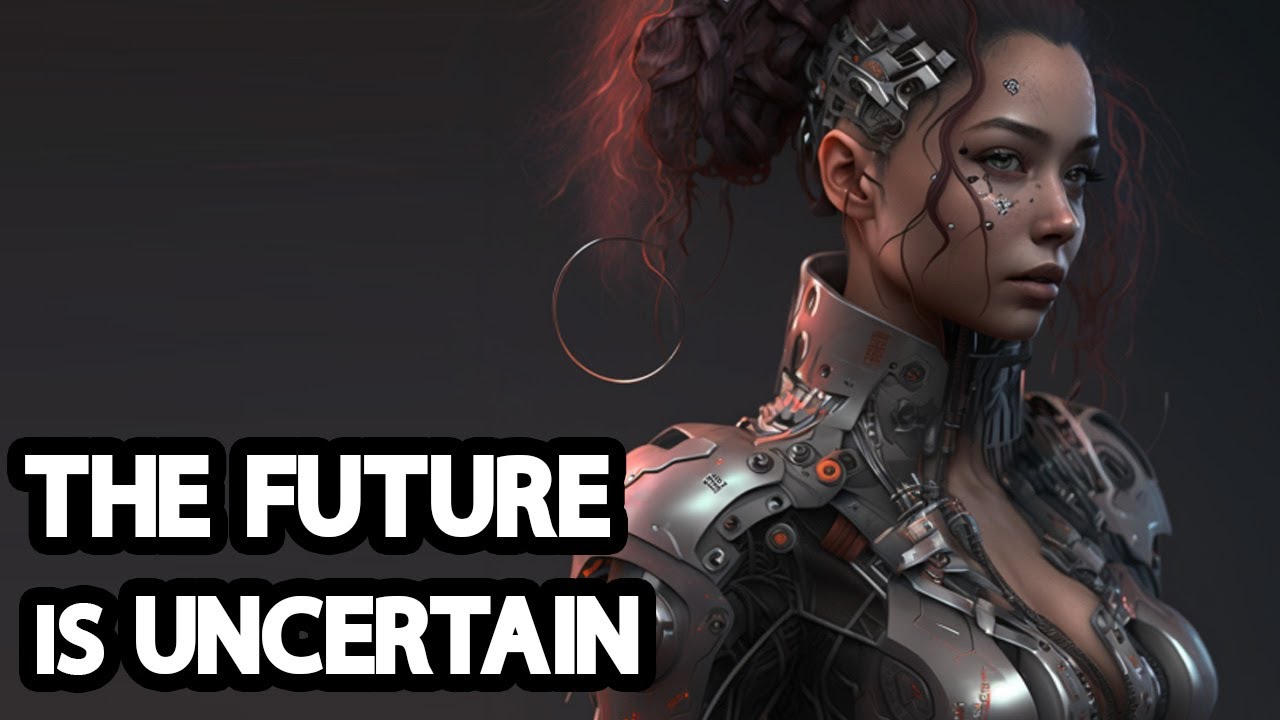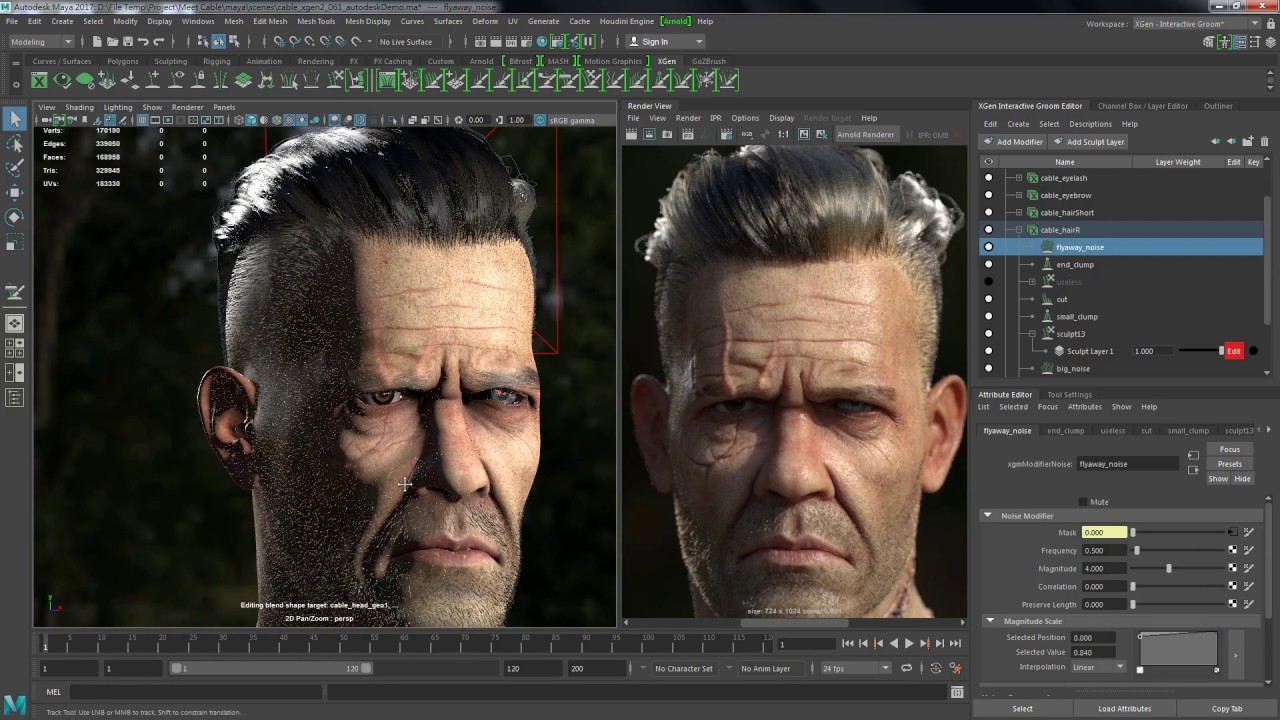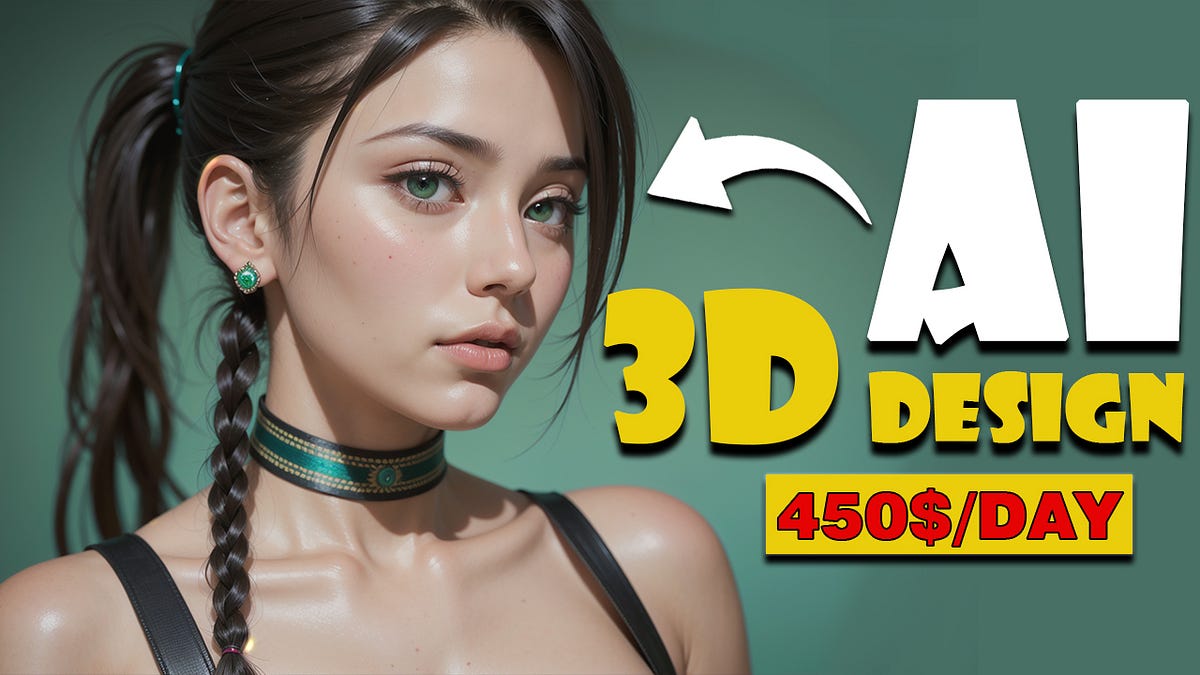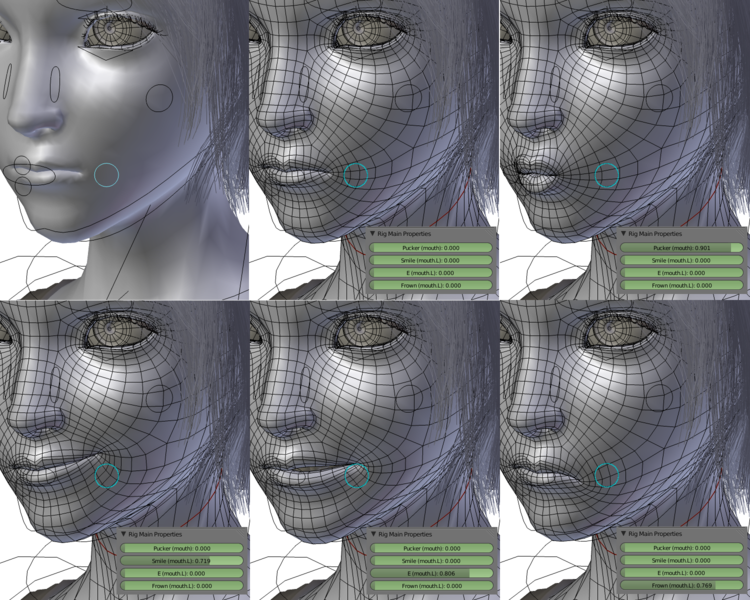The use of AI in 3D modeling and animation for design projects is revolutionizing the creative landscape. No longer a futuristic fantasy, AI is actively reshaping workflows, accelerating production, and pushing the boundaries of what’s possible in design. From automating tedious tasks like rigging and texturing to generating entirely new 3D assets, AI offers both unprecedented speed and creative potential.
This exploration delves into the current applications, future implications, and ethical considerations surrounding AI’s integration into the 3D design process.
This article will examine various AI-powered tools, analyzing their functionalities and comparing their effectiveness. We’ll explore how AI impacts the creative process, addressing both its advantages and limitations. The discussion will also encompass the optimization of 3D models for diverse applications, including gaming and film, and speculate on the future role of AI in the industry, including potential challenges and ethical considerations.
AI-Powered 3D Modeling Tools and Software
The integration of artificial intelligence (AI) is revolutionizing 3D modeling and animation, offering designers unprecedented capabilities in speed, efficiency, and creative exploration. AI-powered tools are automating tedious tasks, generating novel designs, and pushing the boundaries of what’s possible in 3D creation. This section delves into the functionalities of leading AI-driven 3D modeling software, compares different AI algorithms, and analyzes the advantages and disadvantages of this technology compared to traditional methods.
Functionalities of Leading AI-Driven 3D Modeling Software
Leading AI-driven 3D modeling software packages offer a range of functionalities designed to streamline the design process. These tools leverage various AI algorithms to automate tasks such as mesh generation, texture creation, and even the generation of entire 3D models from text descriptions. For instance, some software can intelligently upsample low-resolution models to higher fidelity, while others can automatically generate realistic textures based on a given image or description.
Advanced features include AI-assisted sculpting, allowing for intuitive manipulation of 3D models, and the ability to create variations of a design with minor alterations, facilitating rapid prototyping and iterative design refinement. These functionalities significantly reduce the time and effort required for traditional 3D modeling, enabling designers to focus on higher-level creative aspects of their projects.
Comparison of AI Algorithms Used in 3D Model Generation
Several AI algorithms power the generation of 3D models. Generative Adversarial Networks (GANs) are frequently employed to create realistic and diverse models. GANs consist of two neural networks—a generator that creates models and a discriminator that evaluates their realism. Through a competitive process, the generator learns to produce increasingly realistic models. Another popular approach involves using variational autoencoders (VAEs), which learn a compressed representation of 3D models and can generate new models by sampling from this latent space.
Diffusion models, which gradually refine noise into coherent 3D structures, are also gaining traction. The choice of algorithm depends on the specific application and desired characteristics of the generated models. GANs excel at generating high-quality, realistic models, while VAEs are better suited for generating diverse models with controlled attributes. Diffusion models offer a balance between realism and control.
Advantages and Disadvantages of Using AI in 3D Modeling
AI-powered 3D modeling offers several advantages over traditional methods. The automation of repetitive tasks significantly increases efficiency and reduces production time. AI can also generate novel designs and explore a wider range of possibilities than a human designer might consider, fostering creativity and innovation. Furthermore, AI can help bridge the skill gap by assisting less experienced designers in creating high-quality models.
However, there are also disadvantages. AI-generated models may sometimes lack the fine detail and artistic nuance achievable through manual modeling. The reliance on AI also raises concerns about intellectual property and the potential for bias in the algorithms. Moreover, the computational resources required for AI-driven 3D modeling can be substantial, limiting accessibility for some users.
Comparison of Five Popular AI-Powered 3D Modeling Tools
The following table compares five popular AI-powered 3D modeling tools, highlighting their key features and pricing models. Note that pricing can vary depending on the specific subscription or license.
| Tool | Key Features | AI Algorithms | Pricing |
|---|---|---|---|
| XYZ Studio (Example) | AI-assisted sculpting, automatic texture generation, mesh optimization | GANs, VAEs | Subscription-based, varying tiers |
| ABC Creator (Example) | Text-to-3D model generation, style transfer, model variation | Diffusion models, GANs | Freemium model with paid features |
| DEF Modeler (Example) | AI-powered upscaling, automatic rigging, animation assistance | VAEs, convolutional neural networks | One-time purchase or subscription |
| GHI Designer (Example) | AI-driven design suggestion, parameter optimization, collaborative tools | Reinforcement learning, GANs | Project-based pricing |
| JKL Generator (Example) | Fast 3D model generation from sketches, automatic UV mapping | GANs, diffusion models | Subscription with different user tiers |
AI in 3D Animation Workflow

Artificial intelligence is rapidly transforming the 3D animation pipeline, automating previously time-consuming tasks and empowering artists to focus on creative vision. This section details how AI is impacting various stages of animation production, from initial concept to final render. The integration of AI tools promises significant increases in efficiency and allows for the exploration of new creative possibilities.AI’s role in automating various stages of 3D animation pipelines is multifaceted.
It streamlines processes, reduces manual effort, and enhances overall productivity. This automation is particularly valuable in large-scale projects where manual processes would be prohibitively time-consuming.
AI-Accelerated Rigging
AI algorithms are improving the efficiency and accuracy of rigging, the process of creating a virtual skeleton for 3D characters. Traditional rigging is a painstakingly detailed process requiring significant expertise. AI-powered tools can automate the creation of rigs, reducing the time required and allowing animators to focus on the performance aspects of animation. For example, some AI tools can analyze a character model and automatically generate a rig based on its anatomy, significantly reducing the manual work involved in placing joints and defining constraints.
This automation not only saves time but also increases consistency in rigging across multiple characters.
AI-Powered Texturing
Texturing, the process of applying surface detail to 3D models, is another area where AI is making a significant impact. AI algorithms can analyze images and automatically generate realistic textures, reducing the need for manual painting and editing. AI-powered tools can also intelligently fill in gaps and inconsistencies in existing textures, improving the overall quality and realism of the final render.
Imagine an AI automatically generating realistic wood grain textures for a table model, based on a few example images, saving hours of manual texture creation. This allows artists to explore more textures and variations in less time.
AI Enhancement of Rendering
Rendering, the process of generating final images from 3D models, is computationally intensive. AI algorithms can optimize the rendering process, reducing render times and improving image quality. AI-powered denoising techniques can significantly reduce the noise in rendered images, resulting in cleaner and more refined visuals. Additionally, AI can help predict optimal rendering settings, minimizing trial-and-error and speeding up the overall workflow.
For instance, AI can analyze a scene and automatically determine the best lighting and shadow settings for optimal visual appeal.
AI’s Impact on the Creative Process
AI’s influence on the creative process is not limited to automation; it also opens up new creative avenues. AI tools can assist animators in exploring different styles and techniques, offering suggestions and generating variations based on their input. This allows animators to experiment with different ideas more quickly and efficiently, leading to more innovative and expressive animation. AI can act as a creative partner, providing assistance and suggestions without replacing the artist’s role.
It empowers animators to focus on artistic expression, leaving the tedious aspects of the process to the AI.
Improving 3D Animation Project Efficiency with AI: A Step-by-Step Guide
The integration of AI can significantly streamline the 3D animation workflow. Below is a step-by-step guide illustrating how AI can be used to improve the efficiency of a typical project.
- Concept and Modeling: Leverage AI-powered tools for initial concept sketching and model generation. AI can assist in creating variations of initial concepts based on artist input, streamlining the early stages of design.
- Rigging: Utilize AI-driven rigging software to automatically generate rigs for characters and objects. This significantly reduces the time spent on manual rigging.
- Animation: Employ AI tools for motion capture data cleanup and retargeting, ensuring smoother and more realistic animations.
- Texturing: Use AI to generate realistic textures based on reference images or descriptions, reducing manual texturing effort.
- Lighting and Rendering: Implement AI-powered rendering optimization techniques to reduce render times and improve image quality. AI can also help in automated lighting adjustments.
- Post-Production: Utilize AI for tasks such as denoising and upscaling, enhancing the final output quality.
AI for Generating 3D Assets and Environments: The Use Of AI In 3D Modeling And Animation For Design Projects
The integration of artificial intelligence into 3D modeling and animation pipelines is revolutionizing the creation of digital assets and environments. AI algorithms, trained on vast datasets of 3D models and images, can now generate realistic and complex assets with unprecedented speed and efficiency, significantly impacting design workflows across various industries. This capability opens up new creative possibilities and streamlines the production process, allowing designers to focus on higher-level creative decisions.AI-driven 3D asset generation typically involves feeding the AI model with input parameters such as text descriptions, sketches, or even low-resolution 3D models.
The AI then uses this input to generate a high-fidelity 3D model, leveraging deep learning techniques to understand and interpret the input and generate corresponding geometry, textures, and materials. The process can be iterative, with designers refining the generated asset through manual adjustments or providing further input to the AI to achieve the desired outcome.
Comparison of AI-Generated and Manually Created 3D Assets
AI-generated assets are rapidly approaching the quality and realism of manually created models, particularly for simpler objects and environments. However, significant differences remain. Manually created assets often exhibit more intricate details, nuanced textures, and a higher level of artistic control. AI models, while capable of generating impressive results, can sometimes struggle with complex geometries, subtle variations in materials, and the accurate representation of fine details.
The level of realism also depends heavily on the quality and quantity of the training data used to train the AI model. For instance, an AI trained on a dataset of highly detailed architectural models will produce more realistic buildings than one trained on a limited dataset of low-resolution images. A manually created model of a complex character, on the other hand, would typically possess more expressive features and anatomically correct proportions compared to an AI-generated counterpart, though AI models are rapidly improving in this area.
Limitations of Current AI Technologies in Generating Complex 3D Assets
Current AI technologies still face several limitations in generating highly complex 3D assets. One key challenge is the generation of consistent and coherent details across large-scale environments. AI models can sometimes produce inconsistencies or artifacts, especially in areas that require intricate detailing or complex interactions between different objects. Another limitation lies in the controllability of the generation process.
While designers can provide input parameters, they often have limited control over the fine details of the generated assets, requiring significant post-processing and manual adjustments. Furthermore, the computational resources required to train and run these AI models can be substantial, limiting accessibility for smaller studios or individual artists. Finally, issues related to intellectual property and copyright concerning the training data used by these AI models remain a significant area of ongoing discussion and development.
Types of 3D Assets Effectively Generated Using AI
The ability of AI to generate various 3D assets is expanding rapidly. It’s crucial to understand which asset types currently benefit most from AI assistance.
- Simple Objects: AI excels at generating basic shapes, furniture, props, and everyday objects. These assets often require less detailed modeling and texturing, making them ideal candidates for AI generation.
- Procedural Textures: AI can create intricate and realistic textures, such as wood grain, marble, or fabric, significantly reducing the time and effort required for manual texturing.
- Low-Poly Models: AI can efficiently generate low-poly models suitable for games or real-time rendering applications, where detailed geometry is not necessary.
- Environments (basic): AI can generate basic environments, such as forests, city streets, or landscapes, providing a starting point for more detailed manual work.
- Character Sketches: AI can generate initial character designs based on text prompts or sketches, providing a foundation for more detailed character modeling.
AI and Design Optimization in 3D Projects

Artificial intelligence is rapidly transforming the 3D modeling and animation landscape, extending beyond asset creation to significantly enhance the design optimization process itself. AI algorithms can analyze designs, identify weaknesses, and suggest improvements, leading to more efficient workflows and superior end products. This optimization extends across various aspects, from improving usability and functionality to resolving design conflicts and enhancing performance for specific applications.AI’s ability to analyze vast datasets and identify patterns allows for significant improvements in design efficiency and quality.
This section will explore specific applications of AI in optimizing 3D designs for various purposes, focusing on its role in enhancing usability, resolving conflicts, and improving performance in demanding applications like gaming and film production.
AI-Driven Enhancement of 3D Model Usability and Functionality, The use of AI in 3D modeling and animation for design projects
AI algorithms can analyze 3D models to identify potential usability issues. For instance, an AI could assess the ergonomics of a chair design, flagging areas where the model might be uncomfortable or impractical for its intended use. Similarly, AI can evaluate the accessibility of a building model, ensuring compliance with accessibility standards and suggesting improvements to enhance user experience for people with disabilities.
This predictive analysis goes beyond simple visual inspection, offering quantifiable data to support design decisions and improve the overall user experience. The integration of AI-driven simulation tools allows designers to test different iterations virtually, significantly reducing the need for costly and time-consuming physical prototypes.
AI in Resolving Design Conflicts and Improving Design Quality
In complex projects involving multiple designers or stakeholders, design conflicts are inevitable. AI can play a crucial role in resolving these conflicts by analyzing different design iterations and identifying areas of disagreement. By comparing various design options against pre-defined criteria or user feedback, AI can pinpoint areas requiring compromise or further refinement. This objective analysis helps to streamline the decision-making process, reducing delays and improving overall design quality.
Furthermore, AI can identify subtle design flaws or inconsistencies that might be missed by human designers, leading to a more polished and professional final product.
AI Optimization of 3D Models for Gaming and Film
The performance of 3D models is critical in gaming and film. High-polygon models can strain system resources, impacting frame rates and overall performance. AI can optimize models by reducing polygon count while maintaining visual fidelity. This process, known as polygon reduction or mesh simplification, can significantly improve performance without sacrificing visual quality.
AI-powered tools can automatically identify and remove unnecessary polygons, optimizing models for specific hardware targets. This allows game developers to create visually stunning environments and characters without compromising performance.
Furthermore, AI can assist in optimizing texture maps, reducing file sizes and improving loading times. In film production, AI can enhance rendering efficiency by optimizing lighting and shadow calculations, reducing rendering times and freeing up valuable resources. This leads to faster production cycles and reduced costs. For example, AI can analyze a scene and automatically adjust lighting parameters to create realistic and visually appealing results, significantly reducing the workload on lighting artists.
By analyzing the scene’s geometry and lighting conditions, AI can automatically generate optimized lighting setups, resulting in faster rendering times and improved visual quality.
The Future of AI in 3D Modeling and Animation

The integration of artificial intelligence into 3D modeling and animation is rapidly evolving, promising a future where design processes are significantly faster, more efficient, and accessible. This transformative technology is poised to reshape the industry, impacting not only the tools used but also the roles and responsibilities of professionals within it. We will explore the predicted trends, potential challenges, and the evolving landscape for 3D artists in the age of AI.
Predicted Trends and Developments
AI’s influence on 3D modeling and animation will extend beyond simple automation. We can anticipate advancements in generative AI models capable of creating highly realistic and complex 3D assets from simple text prompts or sketches. Imagine specifying “a futuristic cityscape with flying vehicles and towering skyscrapers” and having the AI generate a photorealistic 3D model complete with textures and lighting within minutes.
This level of automation will dramatically reduce production time and costs, allowing for rapid prototyping and iteration in design projects. Further development will likely focus on refining AI’s ability to understand artistic intent and stylistic preferences, allowing for greater creative control and personalized outputs. For instance, an artist could input a specific painting style and have the AI generate a 3D model that captures the essence of that style.
This will open up new creative avenues for artists and designers.
Potential Challenges and Ethical Considerations
The widespread adoption of AI in 3D design presents several ethical challenges. One key concern is the potential for job displacement. As AI handles more routine tasks, the demand for entry-level 3D modelers and animators might decrease. However, this shift will likely create new roles focused on AI training, prompting, and refinement, requiring skilled professionals to guide and supervise the AI systems.
Another crucial ethical consideration is the potential for AI-generated content to infringe on existing copyrights or intellectual property. Ensuring proper attribution and addressing potential legal issues related to AI-generated art will be paramount. Furthermore, biases present in training datasets could lead to AI-generated models that perpetuate harmful stereotypes or lack diversity. Addressing these biases and ensuring fairness and inclusivity in AI-generated content is vital for responsible development and deployment.
Changes in Roles and Responsibilities
The integration of AI will fundamentally alter the roles of 3D modelers and animators. Instead of spending hours meticulously creating individual assets, artists will likely focus on higher-level tasks such as concept design, artistic direction, and AI system training and refinement. They will become curators and guides, shaping the AI’s output to meet their creative vision. The emphasis will shift from technical proficiency in specific software to a deeper understanding of AI’s capabilities and limitations, along with strong creative vision and problem-solving skills.
The role of the artist will evolve from a technician to a creative director, leveraging AI as a powerful tool to realize their artistic ambitions.
A Futuristic 3D Design Process
Imagine a design studio where artists work collaboratively with AI assistants. The studio is bathed in soft, ambient light, with large holographic displays showcasing 3D models in real-time. An artist sketches a rough concept on a digital tablet, and the AI instantly generates a detailed 3D model based on the sketch, adjusting textures, lighting, and even animation based on voice commands.
The artist then interacts with the model using intuitive hand gestures and voice commands, refining details and experimenting with different stylistic options. The AI provides real-time feedback, suggesting improvements and highlighting potential inconsistencies. Once the model is finalized, the AI generates various renderings and simulations, automatically optimizing the model for different platforms and applications. The entire process is fluid, collaborative, and incredibly efficient, enabling artists to focus on the creative aspects of design while AI handles the technical complexities.
This process is not simply about faster production; it is about unlocking new creative possibilities, enabling artists to explore ideas and iterate designs at an unprecedented pace.
Final Conclusion

The integration of AI into 3D modeling and animation is not simply a technological advancement; it’s a paradigm shift. While challenges remain regarding ethical considerations and the potential displacement of human roles, the benefits in terms of efficiency, creative exploration, and the generation of complex assets are undeniable. The future of 3D design promises a collaborative partnership between human creativity and artificial intelligence, leading to innovative and visually stunning results that were once unimaginable.
The journey is just beginning, and the possibilities are vast.

